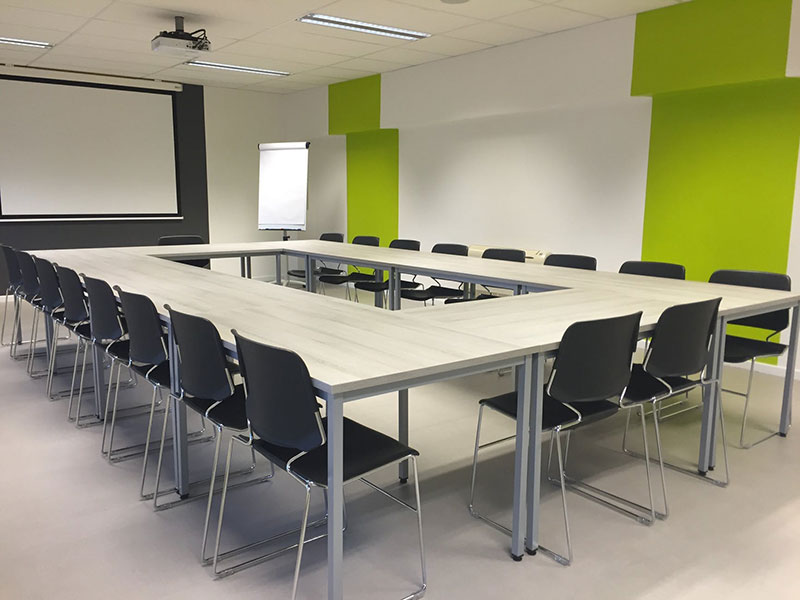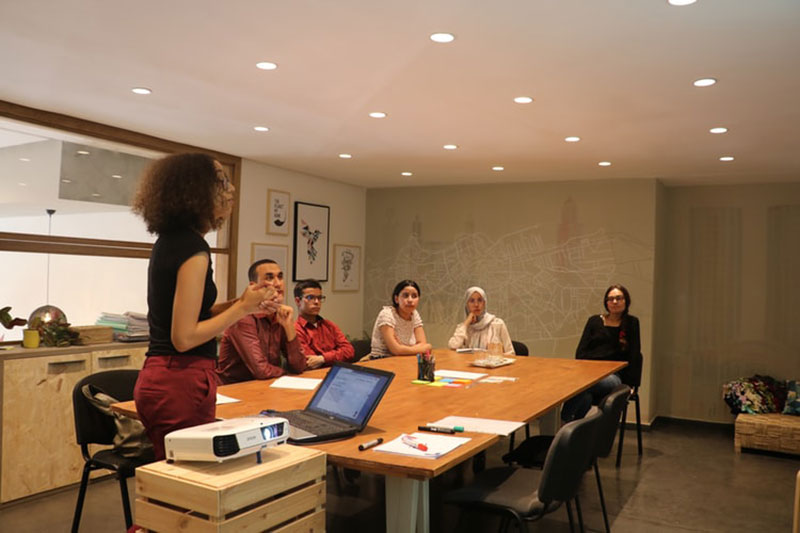The concept of a war room in project management has been around for a long time. However, many people still do not know about this concept. When you think or hear of a war room, you probably would not think of business and banking today, right? However, war rooms are a very real thing in the world of banking.
War rooms were first introduced during war times, unsurprisingly, which is where the name originates from. War rooms were used by generals and military leaders to discuss tactics and strategies to move the war forward. This is exactly how it is still used today, but in project management, as opposed to war.
Project management consists of creating plans and strategies to manage resources to complete projects. These projects are time-based goals to create something, such as a service of worth. War rooms are ideal for getting together and discussing the management of these projects, which may require a lot of interaction between people, resulting in meetings.
Business meetings are held in war rooms often. During these meetings, top executives talk about project planning and execution, as well as discuss the means of how to finish and complete the given project.
Key takeaways
- Origins and Modern Usage: Initially utilized by military leaders for strategizing, war rooms in project management are dedicated spaces for planning and executing large-scale projects, fostering intensive interaction and idea exchange among team members
- Principles of Operation: A war room facilitates effective communication, involving all team members equally, and uses visual aids like whiteboards for brainstorming and strategy formulation. It is designed to be a dynamic space that supports quick decision-making and creative problem-solving rather than routine meetings
- Project Planning and Execution: War rooms are particularly important for managing complex projects, providing a centralized location where project teams can focus on planning efficiently and preparing for project activities without external disruptions
- Inclusivity and Visualization: The war room emphasizes equal participation and the use of visual tools to represent data and project metrics, ensuring that all team members have clarity on the project’s progress and can contribute to its success
What is a war room?

The term “war room” stems from the military efforts during the WW1 and WW2. The first war room was used in 1901, and it was located at military headquarters. The military leaders and strategists would meet in this war room, and they would discuss strategies on how to win the war.
The most well-known war room was used by Winston Churchill during World War 2. In modern-day London, you can find a museum dedicated to this very war room, where Churchill would meet with generals and military leaders to discuss the strategies and plan the tactics of how to beat the Germans during the war.
Since there have been no significant wars recently, the term war room has been borrowed for use in other areas. Most notably, in project management, which we will discuss here in this article. So, what is a war room in terms of project management? A war room is usually a single room within the business headquarters that contains whiteboards and computers to help the people plan a strategy.
In a project management war room, seeds of a good project are sewn, and it is often the place where agents and directors spend most of their time during the project. It is a place where project teams and agents meet and discuss project activities and combine ideas. A war room is especially important for bigger projects that require effective communication.
The bigger the project, the harder it is to manage all aspects of the project, which is where war rooms come into play. It is important during the planning phase to have effective conversations in order to push the project through and plan it efficiently. The war room acts as a place where ideas are gathered and a good place to brainstorm and produce new ideas so that the plan is without flaws. Executives and project teams will spend most of their time in the war room, preparing things for the next project.
How Does a War Room Work?

The basic principle of the war room is to gather all people responsible for carrying out the project in one room where they can communicate easier and gather thoughts together. Mostly, the war room is a physical room, but it can also be virtual or a combination of both. Whatever shape it is in, these are the main principles of a war room.
Effective Communication
Everyone in the room should be able to see and hear everything that is being discussed and have the freedom to contribute to the project. Every piece of information should be conveyed clearly.
Surface Area is Used
In every war room, there should be enough space to write, such as an interactive whiteboard, chalkboard, or walls. It should be the focal point of the room, somewhere where everyone can see and hear what is being said clearly.
Want to give your career a chance? Check out this course from Google.
Take the Google-designed project management course and prepare for a high-paying career in an in-demand field with over 715,000 open jobs, regardless of your experience or degree, and get the chance to apply for jobs with Google and other top U.S. employers.
Everyone Should be Involved
The war room should be a place of equality where everyone has the ability to present their own ideas and thoughts on the project.
Additionally, it should be done in such a way that everyone can hear and see everything that is being discussed. This creates a feeling of accountability, dedication to the project, and equality among the members.
Visualization
The aspect of visualization is very important for war rooms. In addition to the surface area, the war room should contain lots of visual representations where different metrics or numbers are presented. This includes sticky notes, graphs, photos, wireframes, tables, user interface designs, and more. This is where data and information about the project should be presented clearly.
Variety
To cover all aspects of the projects, other people from other fields should sometimes be invited to present an alternative perspective.
A War Room is Not a Meeting Room
The purpose of the war room is creativity, not as a meeting room where directors meet. The war room should be for creative debates and not business debates.
Quick Decisions
Sometimes, the decision should be taken quickly to move the project forward. Other times, the decision should be considered over a longer period.
Are you looking for a great project management app?
Here are our recommendations:
Why is a War Room Good?
What is a war room, and what are the benefits that it brings? Here, we will cover just that.
Effective Communication
The biggest and most notable benefit of a war room is that it enables effective communication between members of the team.
Meeting people in a war room is more efficient than conveying ideas over the phone or through email. A lot of information might get lost in any other meeting situation, and it is better to meet in person.
The team can really focus on the project in person, eliminating all potential disturbing factors of all other types of communication, such as the telephone.
The Information Can Be Managed Easily
Another benefit of a war room is that visualization is much easier in the war room due to the technology and gadgets used there. Computers, whiteboards, and walls can be used as places where visual information is conveyed, which enables a much easier, more effective visualization of the data and facts that are in question.
Better Focus
When people are there for the sole purpose of pushing the project forward, there should always be more focus on the project.
In the war room, there are likely to be no other disturbances that would shift the focus of people in there, and the project is made the primary focus of the team.
Better Chemistry Between People
This is an aspect that cannot be neglected and is sometimes the decisive aspect of whether a project is successful or not.
The team can grow together and develop chemistry between them, which can increase the chances of success. The room works as one, and the focus of the people is on the same thing.
It allows members of the team to bond and creates a mutual understanding that would not have been possible if they were not in a war room.
Visual Data Is Easier to Manipulate
In a war room, there is likely to be plenty of visual data on display. This data is made in such a way that it is easy to manipulate and, consequently, much easier to understand.
If it was conveyed with words, it would likely not be as powerful as it is in its visual form.
What is the war room equipment?

A war room’s equipment can vary depending on the project. A war room can be simple and inexpensive, or it could be a collection of high-tech equipment. The basic equipment is the same in both types of rooms. Larger companies are more likely to have a more expensive war room, while smaller companies can turn their offices into a war room with a few simple adjustments.
One of the most important things to remember about war rooms is that they must have enough space. Both types should have more than enough space on the walls to portray and visualize data and create a feeling of a war room. This can be done by simply rearranging the furniture within a room, or by putting equipment in a separate room. Some can be quite fancy, while others are primitive but still very effective.
So, what is war room equipment? What are the essential components of a good war room? One of the most important things is to have a place to draw and write. Ideally, it should be a whiteboard. For drawing, you will also need plenty of whiteboard markers of different colors, which will allow you to present things more clearly.
Next, you should have sticky notes in different colors. Sticky notes are a cheap but effective investment for your project. The important thing is also that the furniture is flexible – meaning that the furniture should be able to be used when needed; when you need to sit down and talk, chairs should be ready to be deployed. When you need more space, the furniture should be arranged so.
Printers, scanners, and copiers are very important pieces of equipment as well. You do not have to spend too much on a war room, but these gadgets can be very important.
Lastly, a war room should be an isolated room, away from external factors that may affect your team’s productivity. The members should leave their phones out of the room. Keep the distraction level at a minimum.

Lanyards are typically worn around the neck and have long been associated with identifying individuals within an organization. A Custom Lanyard features team logos, colors or slogans as a visual representation of the team’s identity. Each time a team member wears these lanyards, it increases the member’s sense of team identity.
Hopefully, you now have a better idea of what is a war room and you will be able to get together a team to work effectively in one.
FAQs about what a war room is
1. What is a war room, and what is its purpose?
A war room is a designated area where a team can collaborate to plan and handle a task, circumstance, or crisis.
Its goal is to make it easier for team members who must cooperate closely to accomplish a common goal to communicate, collaborate, and make decisions.
One can build up a war room for several things, including crisis management, project management, or even election monitoring.
2. How is a war room different from a regular conference room or meeting room?
A war room is distinct from a typical conference room or meeting space since it is made with teamwork and decision-making in mind.
A war room differs from a standard conference room in that it has specific tools and equipment, like big screens, whiteboards, and projectors, that aid team members in visualizing and analyzing data.
Team members can collaborate for long stretches of time without an interruption in this private, pleasant location.
3. Who typically uses a war room, and in what industries or situations is it commonly used?
Every team or organization that has to coordinate and manage difficult tasks or circumstances can use a war room.
It is frequently employed in sectors including technology, banking, and government where quick decision-making and teamwork are required.
A war room can be used for several things, including project management, product creation, marketing strategy, and crisis management.
4. What features or equipment are typically found in a war room?
An array of tools and features are often included in a war room to facilitate teamwork and decision-making.
Large screens or video walls for showing data, whiteboards or chalkboards for brainstorming, conference tables and chairs, and a variety of note-taking and organization tools and supplies are a few examples of what might be provided.
It might also come with specific software and equipment for project management, communication, and data analysis.
5. How do you set up and organize a war room?
A war room requires several important setup and organization tasks. The team should first decide on the war room’s function and list the tools and resources that are required. The following step is to furnish the area with the required furnishings, screens, and whiteboards.
The team should define ground rules and processes for communication and collaboration once the space is ready, as well as delegate duties and obligations to team members.
To make sure that the setup of the space and equipment is meeting their needs, the team should regularly assess and adjust it.
6. What types of information or data are typically displayed or analyzed in a war room?
The kinds of data and information that are displayed or examined in a war room depend on the needs of the team as well as the space’s intended use.
For instance, the team in a crisis management war room might be examining current information about the issue, such as weather patterns or news stories.
The team may be reviewing project timetables, costs, and resources in a project management war room. Maps, charts, graphs, and tables are just a few examples of the various tools that can be used to represent the data.
7. How does a war room facilitate decision-making and problem-solving?
A war room helps decision-making and problem-solving by assembling team members with various specialties and viewpoints and giving them the tools and resources they need to work well together.
Team members can spot issues and opportunities more immediately and build solutions more effectively by displaying and analyzing data in real time.
The war room offers a designated area where team members may concentrate on their current tasks and collaborate without distractions.
8. Can a war room be used remotely, or does it need to be a physical location?
Depending on the demands of the team, a war room can be used remotely or in person. Several of the tools and gadgets that were previously only found in a physical war room, such as big screens and video conferencing capabilities, may now be accessed remotely thanks to technological improvements.
More flexibility and accessibility for team members who may be dispersed throughout the globe are just two advantages that remote war rooms can provide.
However, having a physical war room may be preferred by some firms as it can give a dedicated area for collaboration and some benefits, such as more secure communication connections.
9. How do you ensure that a war room is secure and confidential?
Setting up a war room requires taking security and secrecy into account, especially if it will be utilized for crisis management or other delicate scenarios. The team should set up access control and communication mechanisms to guarantee the war room’s security and confidentiality.
To do this, you might build password-protected communication channels, restrict access to the area to team members who have been given permission, and use encryption and other security measures to safeguard sensitive data.
Guidelines for the handling and disposal of confidential material should also be established by the team.
10. How does the use of a war room affect the outcome of a project or situation?
The utilization of a war room can significantly affect how a project or crisis turns out. The war room can help to expedite problem-solving, discover opportunities and dangers more quickly, and boost the efficiency and effectiveness of the team by offering a dedicated location for collaboration and decision-making.
Also, it can help team members feel motivated and committed to one another, which is beneficial in high-stress circumstances. The capacity of the team to collaborate well and make the most use of the tools and resources at their disposal is ultimately what determines whether a war room will be successful.
If you enjoyed reading this article on what is a war room, you should check out this one about project management framework.
We also wrote about a few related subjects like project management books, project management principles, project management goals, project management metrics, IT project manager, Kanban app, gap analysis, project management skills and project management methodologies.
- Business model vs business plan: What’s the difference between them - February 6, 2024
- What Is A Project Management Framework? (Must Read) - October 15, 2023
- What is an IT Project Manager and What Do They Do? - October 11, 2023












